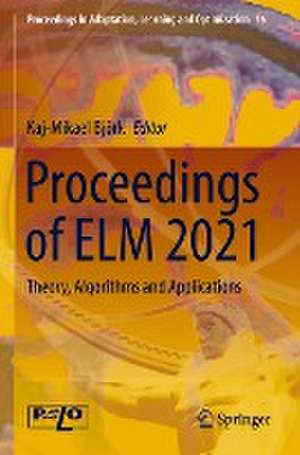Proceedings of ELM 2021: Theory, Algorithms and Applications: Proceedings in Adaptation, Learning and Optimization, cartea 16
Editat de Kaj-Mikael Björken Limba Engleză Paperback – 20 ian 2024
This conference provides a forum for academics, researchers, and engineers to share and exchange R&D experience on both theoretical studies and practical applications of the ELM technique and brain learning. This book covers theories, algorithms, and applications of ELM. It gives readers a glance of the most recent advances of ELM.
| Toate formatele și edițiile | Preț | Express |
|---|---|---|
| Paperback (1) | 1436.76 lei 6-8 săpt. | |
| Springer International Publishing – 20 ian 2024 | 1436.76 lei 6-8 săpt. | |
| Hardback (1) | 1442.88 lei 6-8 săpt. | |
| Springer International Publishing – 19 ian 2023 | 1442.88 lei 6-8 săpt. |
Din seria Proceedings in Adaptation, Learning and Optimization
- 20%
 Preț: 1299.64 lei
Preț: 1299.64 lei - 20%
 Preț: 1280.69 lei
Preț: 1280.69 lei - 20%
 Preț: 1274.57 lei
Preț: 1274.57 lei - 20%
 Preț: 1271.78 lei
Preț: 1271.78 lei - 20%
 Preț: 1912.11 lei
Preț: 1912.11 lei - 20%
 Preț: 1272.61 lei
Preț: 1272.61 lei - 20%
 Preț: 1457.06 lei
Preț: 1457.06 lei - 20%
 Preț: 1750.92 lei
Preț: 1750.92 lei - 20%
 Preț: 1298.33 lei
Preț: 1298.33 lei - 20%
 Preț: 1285.97 lei
Preț: 1285.97 lei - 20%
 Preț: 1283.64 lei
Preț: 1283.64 lei - 20%
 Preț: 1285.45 lei
Preț: 1285.45 lei - 20%
 Preț: 1290.40 lei
Preț: 1290.40 lei - 20%
 Preț: 1289.59 lei
Preț: 1289.59 lei - 20%
 Preț: 993.42 lei
Preț: 993.42 lei
Preț: 1436.76 lei
Preț vechi: 1795.95 lei
-20% Nou
Puncte Express: 2155
Preț estimativ în valută:
274.91€ • 287.06$ • 227.02£
274.91€ • 287.06$ • 227.02£
Carte tipărită la comandă
Livrare economică 15-29 aprilie
Preluare comenzi: 021 569.72.76
Specificații
ISBN-13: 9783031216800
ISBN-10: 3031216806
Ilustrații: VIII, 172 p. 57 illus., 47 illus. in color.
Dimensiuni: 155 x 235 mm
Greutate: 0.26 kg
Ediția:1st ed. 2023
Editura: Springer International Publishing
Colecția Springer
Seria Proceedings in Adaptation, Learning and Optimization
Locul publicării:Cham, Switzerland
ISBN-10: 3031216806
Ilustrații: VIII, 172 p. 57 illus., 47 illus. in color.
Dimensiuni: 155 x 235 mm
Greutate: 0.26 kg
Ediția:1st ed. 2023
Editura: Springer International Publishing
Colecția Springer
Seria Proceedings in Adaptation, Learning and Optimization
Locul publicării:Cham, Switzerland
Cuprins
Pretrained E-commerce Knowledge Graph Model for Product Classification.- A Novel Methodology for Object Detection in Highly Cluttered Images.- Extreme learning Machines for Offline Forged Signature Identification.- Randomized model structure selection approach for Extreme Learning Machine applied to Acid sulfate soils detection.- Online label distribution learning based on kernel extreme learning machine.
Textul de pe ultima copertă
This book contains papers from the International Conference on Extreme Learning Machine 2021, which was held in virtual on December 15–16, 2021. Extreme learning machines (ELM) aims to enable pervasive learning and pervasive intelligence. As advocated by ELM theories, it is exciting to see the convergence of machine learning and biological learning from the long-term point of view. ELM may be one of the fundamental `learning particles’ filling the gaps between machine learning and biological learning (of which activation functions are even unknown). ELM represents a suite of (machine and biological) learning techniques in which hidden neurons need not be tuned: inherited from their ancestors or randomly generated. ELM learning theories show that effective learning algorithms can be derived based on randomly generated hidden neurons (biological neurons, artificial neurons, wavelets, Fourier series, etc.) as long as they are nonlinear piecewise continuous, independent of training dataand application environments. Increasingly, evidence from neuroscience suggests that similar principles apply in biological learning systems. ELM theories and algorithms argue that “random hidden neurons” capture an essential aspect of biological learning mechanisms as well as the intuitive sense that the efficiency of biological learning need not rely on computing power of neurons. ELM theories thus hint at possible reasons why the brain is more intelligent and effective than current computers.
This conference provides a forum for academics, researchers, and engineers to share and exchange R&D experience on both theoretical studies and practical applications of the ELM technique and brain learning. This book covers theories, algorithms, and applications of ELM. It gives readers a glance of the most recent advances of ELM.
This conference provides a forum for academics, researchers, and engineers to share and exchange R&D experience on both theoretical studies and practical applications of the ELM technique and brain learning. This book covers theories, algorithms, and applications of ELM. It gives readers a glance of the most recent advances of ELM.
Caracteristici
Provides recent research on Extreme Learning Machines (ELM) Contains selected papers from the 11th International Conference on Extreme Learning Machines 2022 Presents theory, algorithms, and applications of ELM
